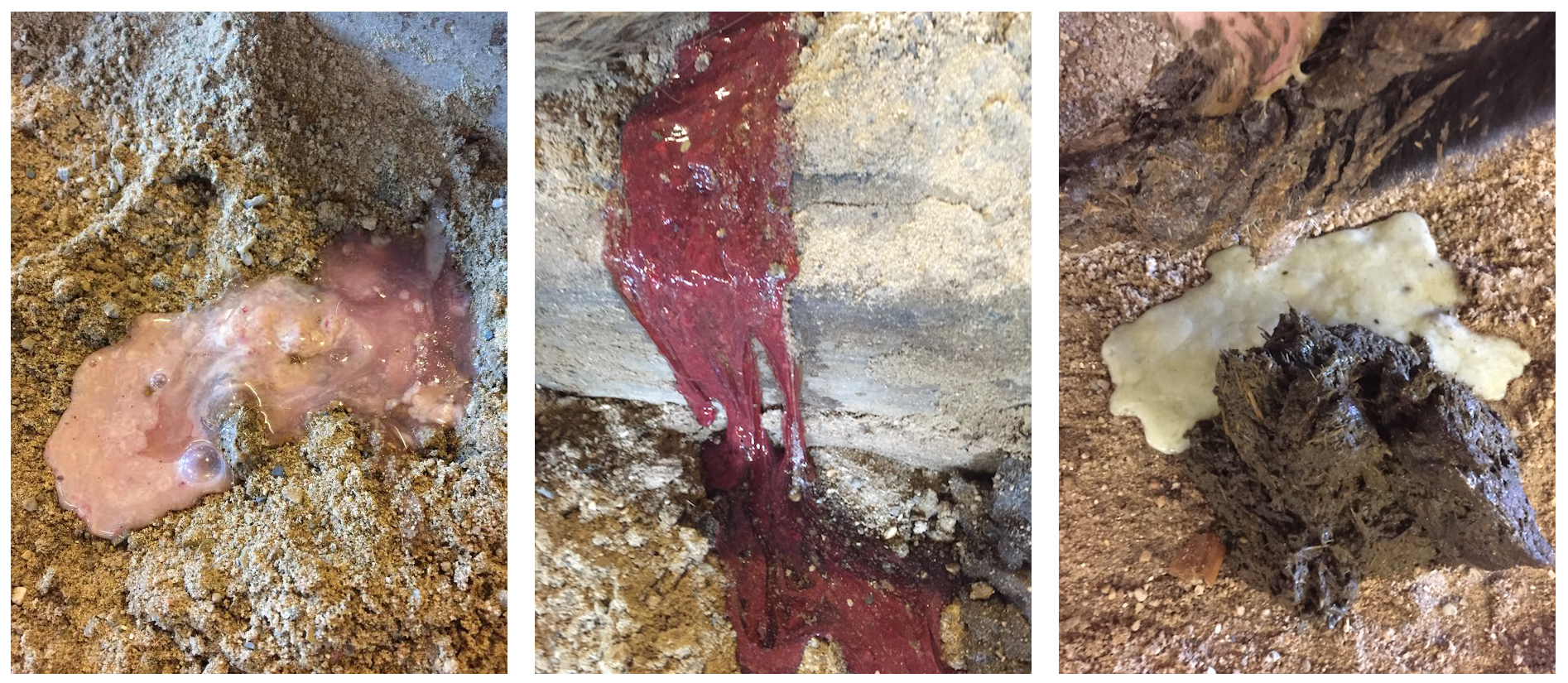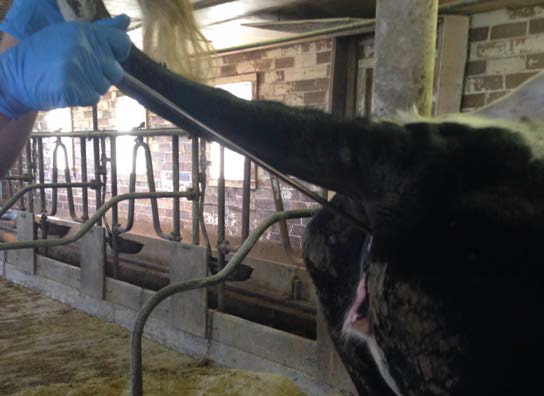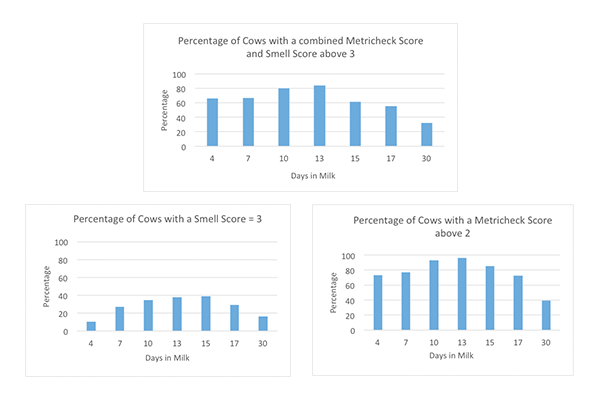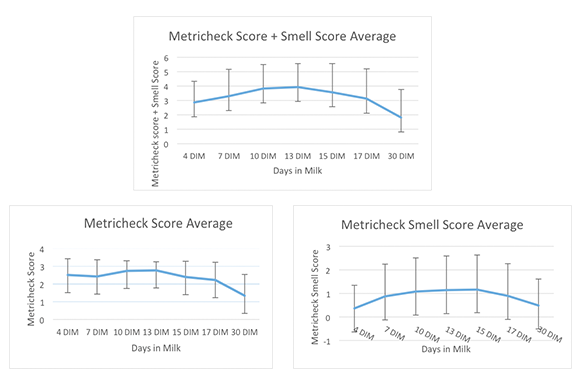Stephanie Stella, Anne Rosi Guadagnin, Angelica Petersen Dias, and Dr. Phil Cardoso
February, 2016
It is no secret that giving birth is a stressful situation for both the cow and her reproductive tract. As a result, the cow’s immune system becomes compromised, which can result in infection from the birthing process. Metritis is the infection and inflammation of the uterus that is common in many high producing dairy cows. This uterine disease can be caused by a difficult birth, retained fetal membranes (also known as retained placenta), nutritional deficiencies, and unsanitary calving environments. Metritis can result in a decrease in fertility and milk production as well as increases in calving intervals and farm culling rate, which can lead to detrimental economic losses for any dairy farm. These costs can range from $100-$300 per metritis case which includes the cost of medication, increased calving intervals, milk withholding, and losses due to culling. A recent survey in 2006 revealed that the average US dairy farm has about 120 cows. Since metritis has a 20% prevalence rate in lactating dairy cows, this means that 24 of the total 120 cows will have metritis after calving. Treating all 24 of these cases would result in an economic loss of $7,200 per year. By detecting and preventing metritis in the early stages, the economic and reproductive losses can be minimized.
Metritis is characterized as the presence of abnormal vaginal discharge that is typically yellow or brownish-red, as seen in Figure 1, with a very strong odor. Depending on the severity of the infection, metritis can also be associated with other systemic symptoms such as lethargic behavior and fever ( > 102.5°F).

Figure 1. Examples of vaginal discharge from cows with metritis.
In many cases, a hard and inflamed uterus can be felt by rectal palpation. The majority of metritis cases occur within the first 14 days after calving

Figure 2. Galvao et al., 2011
with a peak frequency around 5 to 7 days after birth, which can be seen in Figure 2. Although it is not common, metritis can also occur 21 days after calving. Once metritis is diagnosed, the cow should also be examined for other metabolic and infectious diseases, such as ketosis and displaced abomasum, as these diseases are commonly associated with metritis.
The “gold standard” method for the diagnosis of uterine inflammation is cytology. However, this is not a simple procedure and not practical to be done at the farm level. Alternatively, examination of the vaginal contents for the presence of pus can be performed via manual examination of the vagina and withdrawal of the mucus for inspection.
Observing vaginal secretions in free-stall beds is one way of examining vaginal content. However, this method of diagnosis for metritis has shown to be ineffective. In a recent study published in the Journal of Dairy Science, scientists evaluated the effectiveness of using a gloved hand versus using the Metricheck device when diagnosing metritis. The gloved hand method is fairly similar to the procedure of the Metricheck. A gloved hand is simply inserted into the vagina of the cow and the contents are slowly removed and evaluated. The study revealed that the prevalence of metritis was 47.5% and 36.8% for Metricheck and gloved hand, respectively. The Metricheck device was able to diagnose cows with metritis more efficiently when compared with the gloved hand technique.

Figure 3. The Metricheck device.
The Metricheck device is a very practical and economically effective way to evaluate vaginal discharge (Figure 3). The Metricheck device consists of a stainless steel rod with a rubber hemisphere that is used to retrieve the vaginal contents. The Metricheck device is cleaned with a disinfectant, inserted into the vagina of the cow, and then removed while pulling the device out at an upward 45 degree angle (Figure 4).

Figure 4. Withdrawal of Metricheck device at an upward 45 degree angle.
After the vaginal content is collected, it can be scored according to the quality and smell of the mucus, as seen below (Figure 5).

Figure 5. Vaginal discharge scoring for Metricheck (Sheldon et al, 2005).
Using this score system, the mucus can described as:
- Score 0 = clear or translucent mucus;
- Score 1 = mucus containing flecks of white or off-white pus;
- Score 2 = discharge containing ≤ 50% white or off-white mucopurulent material;
- Score 3 = discharge containing ≥ 50% purulent material, usually white or sanguineous.
The smell is classified as not having smell (score 0) or a strong odorous smell (score 3). These scores reflect the presence and the amount of bacteria in the uterus. Vaginal discharge with a smell score of 0 means that there is a low number of pathogenic bacteria in the uterine environment, and vaginal discharge with a score of 3 with a strong smell means indicates the presence of bacterial infection in the uterus. Since 95% of metritis cases occur within the first 14 days postpartum, utilizing the Metricheck device during this time is optimal for detecting metritis. It is also important to remember that metritis can be characterized in various ways depending on the cow’s days in milk. When a cow is less than 10 days in milk, we would expect to observe vaginal discharge that has a strong odor and no pus and can possibly be associated with fever. When a cow is greater than 30 days in milk, we would expect to observe purulent discharge with no blood or smell. This process is very easy to perform, does not require intense training, and is a comfortable and sanitary experience for the cow as compared to the gloved hand method. The Metricheck device is a useful and practical tool to assess mucus of the cranial vagina as an indicator for metritis. A step by step video of how to use the Metricheck device is available from our YouTube channel at https://www.youtube.com/watch?v=jIhd8buSpHU.
Most common treatments for metritis use either intrauterine antibiotics or systemic antibiotics. Systemic antibiotics are more widely approved for use in dairy cows than intrauterine antibiotics. Common systemic antibiotics are ceftiofur hydrochloride, ceftiofur sodium, and ceftiofur crystalline free acid. Crystalline free acid tends to be the antibiotic of choice because it has long lasting effects. However, consultation with the farm veterinarian is always recommended before administering medication. Treatment for metritis is warranted when the cow has a combined Metricheck score and smell score that is above 3. Therefore, the cow would have a vaginal discharge score that is more than half purulent material and the discharge would have a bad odor.
Our group at the University of Illinois at Urbana-Champaign Dairy Farm is evaluating the uterine environment of dairy cows from parturition to early lactation. We are evaluating vaginal discharge using the Metricheck device. From the current data received, 69.7% of the cows on this trial had metritis between 4 to 17 days in milk post calving. Figure 6 shows the percentages of cows with metritis between 4 to 30 days in milk post calving while specifically looking at Metricheck + smell score, smell score, and Metricheck score.

Figure 6. Percentage of cows with metritis for Metricheck + smell score > 3, smell score = 3, and Metricheck score > 2.
The graphs above follow a similar distribution, with the majority of metritis cases ranging from 4 to 17 days in milk.
Figure 7 displays the average scores for Metricheck, smell, and Metricheck + smell in relation to the days in milk. Metritis was characterized in this study by a Metricheck score average above 2, a smell score average above 1, or a combined Metricheck and smell score average above 3. These graphs show that a higher Metricheck score and a high smell score were most prevalent in cows during the 4 to 17 days in milk range.

Figure 7. Average scores for Metricheck, smell, and Metricheck + smell.
Diagnosing metritis at an early stage is beneficial for both the cow and the farm. The Metricheck device allows for accurate diagnosis of metritis so that the cow can be treated as early as possible to avoid further detrimental effects to the cow’s reproductive tract as well as on overall milk production.

